In summary, my media product used many conventions from real products to aid in me creating a fluid plot with good camera shots and angles.
Q2:How Effective is the Combination of Your Main Product and Ancillary Texts
From audience feedback I was told that the combination of my main product and ancillary texts worked quite well together. The most common thing I was told was that 'The use of the same music in the film and in the trailer is very effective as it makes it memorable.'
This is key as the repetition of the song creates familiarisation with the audience and will entice them to want to watch my product. This was also the case with the font in the title sequence in the film and the font in the magazine article. The use of this repetition can create a brand for my film and this will further its popularity. With the theme of 'The struggle for Identity' as my basis, I feel that the picture in my article was quite effective. This is because only showing half of the face connotes that she doesn't have an identity and also implies some sort of struggle.
Overall, I feel that all three products complimented each other and linked quite well into my research and planning.
Question 3: What have you learned from your audience feedback?
Through this audience feedback I learnt ways in which I could improve the production. After interviewing a sample from my target audience, I learnt that many found the plot confusing, some even said that a better actress was needed.
This has lead me to think of ways that I would change my production if I were to do it again, and I thought that I would be better if:
-I had a range of actors/actresses
-Had a more vibrant location
- Thought more about props
I also thought of some additional ideas, such as:
-A variety of ethnicities to be displayed in my production to really show the theme of identity
-I would also add a voice over and sound bridges into the film as it is a way of showing the plot in a different light
I believe that the audience feedback has been very useful for me as it allowed me to see what I could have done differently and showed me what was effective in my product.
Question 4: How did you use media technologies in the construction, research, planning and evaluation stages? on Prezi
I also used my blackberry smartphone to get audience feedback and I obtained this through videos and voice notes. Using varied technologies helped a great deal as it showed my awareness of technology as well ask showing my ability to use social media to improve my outcome.
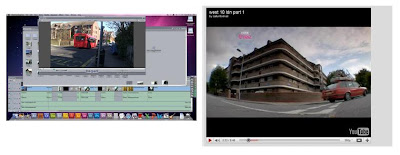
 Time management was an issue that my partner and I could definitely work on. We strayed from the SMART targets that we made previously and this was quite bad as it interfered with editing time. In hindsight I would have had a time management meeting where my partner and I discussed how much time we would spend on each aspect of the production pieces. Our time management was also affected by the delay of the equipment being delivered to our college and other technological problems such as the apple mac computer network being down. In future, I will leave time for problems like this to prevent them affecting my work.
Time management was an issue that my partner and I could definitely work on. We strayed from the SMART targets that we made previously and this was quite bad as it interfered with editing time. In hindsight I would have had a time management meeting where my partner and I discussed how much time we would spend on each aspect of the production pieces. Our time management was also affected by the delay of the equipment being delivered to our college and other technological problems such as the apple mac computer network being down. In future, I will leave time for problems like this to prevent them affecting my work.
Here is the radio trailer we produced using Final Cut Pro Ignore the images, they aren't supposed to be there!!!
Pariah (ORIGINAL)
(Starts with music from the film)
Voice: Sometimes saying nothing is the best thing to do.
Starring Best Newcomer: Debbie Adedeji
From the makers of ‘The Highlife’ comes ‘Pariah’
Reviewer 1: It was a very moving film.
Fade into music and fade out
Reviewer 2: The twist at the end was really unexpected and made the film a must see.
Fade into music and fade out
Reviewer 3: The characters were so realistic and really showed the issue well.
(With music in the background)
-‘Groundbreaking short film of the year’ says The Sun
-‘Manages to portray serious issues in a way that entices the viewer’ says The Independent
-‘A fascinating and captivating tale that compliments the British Film Industry’ says Time Out
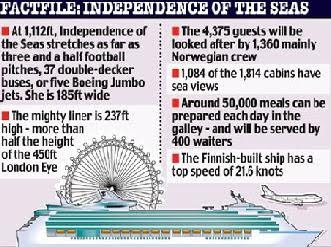
As we didn't use an original track, I sent a message to the creator of the music to ask if i had permission to include it in my film. They agreed and said that they would love to see the finished product.
We chose this as we felt that it fitted in very well with the themes of our film and worked very well with the plot and location.
As the genre of our film is drama, we thought that it would be best that we keep within the genre and find some music to suit this.
When beginning this process, I thought of drama films that I had already seen and the type of music that was used in them. For example, 'Adulthood' had quite dramatic harsh music to portray how the character felt and to show the themes (see below).
The genre of grime music was used in the 'Adulthood' film and it acted as a link to the themes of youth in the film and it linked with the characters and storyline very well. This is what I aim to do with my music choice.
The other genre that I looked at was R&B. This is quite effective as well as the lyrics are meaningful compared to genres such as rap, and the beat can also make a difference and add character to the film. However, as we wanted to use the track in the background of our film, we felt that it would be best if we chose a song without lyrics.
Here is another example of music from a drama film:

Above are some shots from our editing session where we discussed the organisation of clips and the way our montage will look at the end of production. We realised that the current order that it was in didn’t shape the plot properly. We also found that some parts of the film were long and drawn out and that we could cut it to prevent our audience from losing interest. We also found some shots that we could use to create suspense and drama and they were quite shadowy, this would link in with the Neo-Noir movement.
 We wanted our whole production to have good continuity so we thought that it would be good to have one strong font in the title sequence of the film and in the magazine article.
We wanted our whole production to have good continuity so we thought that it would be good to have one strong font in the title sequence of the film and in the magazine article.
At our second meeting we planned dates for filming, as we couldn’t upload our current footage onto the Apple Macs because our college was having some technical difficulties with the computer network.
We also looked at the storyboard and separated it over a course over 3 weeks so we had sufficient time to film each scene.
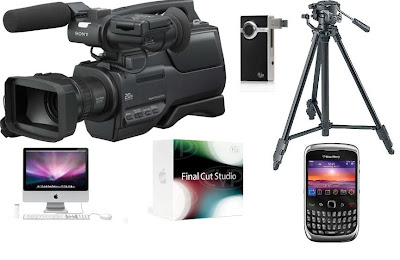

‘Storyboards are graphic organisers such as a series of illustrations or images displayed in a sequence for the purpose of pre-visualising a motion picture, animation, motion graphic or interactive media sequence including website interactivity.' - Wikipedia
The common storyboarding used today was pioneered at the Walt Disney Studio in the 1930s. Gone with the Wind was one of the first live action films to be completely storyboarded.
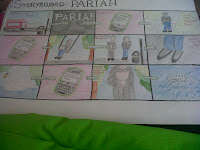
I have used Final Cut Pro before but I need to improve my skills to ensure that the finished product is successful. The first thing I did was refresh my mind with some basic skills:
After filming this, we realised that the quality was quite poor and that it wouldn't look very good as part of our film. As we are incorporating elements of Neo-Noir into our film, we thought of the different technologies we could use to present out characters written thoughts.
Some of our ideas were:
- Computer/Laptop
- Sand on a beach
- Texting on a mobile phone
New Cameras
We FINALLY recieved the new Professional Sony HD cameras! This is quite exciting as we will be able to proceed with our production AT LAST! This will improve the quality of our film significantly and allow us to experiment and try things to give our film a professional look.
UPDATE! :We decided to use a BlackBerry Smartphone to show our character's feelings.
The work done so far will aid us into starting the storyboarding process. It will also help us structure our work to give us time to create an effective film. It will also guide us into more research such as:
I feel that it is important that I research into past and present film directors to get a feel of what film production will be like.
The first film director I am going to look at is Sir Alfred Hitchcock.
Sir Alfred Hitchcock – Born 13th August 1899 and died 29th April 1980
He was an English director and producer and he pioneered many techniques in the thriller genre. He directed more than 50 feature films in an astonishing career spanning six decades. He also pioneered the use of a camera made to mimic a person’s gaze and his shots maximized anxiety and drama which was highly effective in film. His films also embodied psychoanalysis and strong sexual undertones. Through cameo appearances in his own films and through interviews and his own programme ‘Alfred Hitchcock Presents’, he became a cultural icon.
Noel Clarke – Born 6th December 1975
He is an English actor, director and screenwriter from London. He is well known for starring in ‘Auf Wiedersehen’ and ‘Doctor Who’. He studied media at the University of North London. He most notably appeared in and wrote the screenplay for ‘Kidulthood’ and wrote, directed and starred in the sequel ‘Adulthood’, which grossed £1,209,319 on the opening weekend of its release. Clarke has worked with the BBC Blast project for young teenagers and it aims to inspire young people to be creative. He began writing in 2005 .and is still writing today.
His other writing credits include ‘West 10 LDN’ a pilot for BBC Three that is about kids on a rough housing estate. This is significant as our product ‘Pariah’ is also intended to be a pilot for channel 4.
[Below is a clip from 'West 10 LDN']
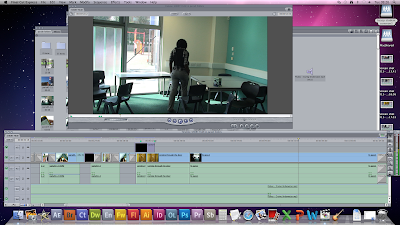
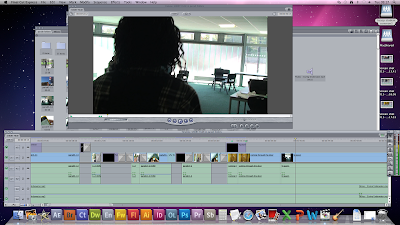
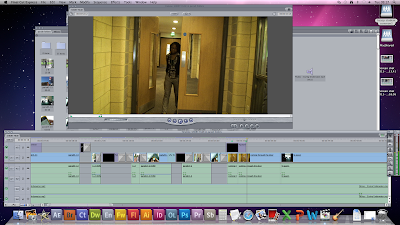
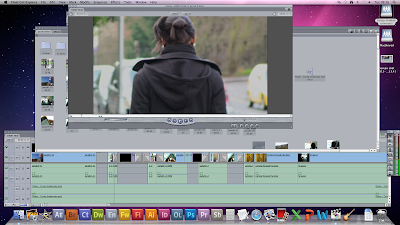
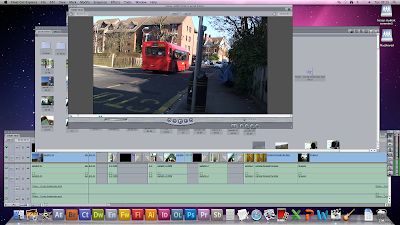
 We tested out the idea of writing in a journal and we decided that it would look better if we did it on a mobile phone. We also decided that we would change the theme to bullying instead of self harming as it could be very effective without looking amateurish. We also changed the idea of the thoughts coming to life as we didn't think it was within our ability to do this.
We tested out the idea of writing in a journal and we decided that it would look better if we did it on a mobile phone. We also decided that we would change the theme to bullying instead of self harming as it could be very effective without looking amateurish. We also changed the idea of the thoughts coming to life as we didn't think it was within our ability to do this.
Brief synopsis of the film
Debbie is having trouble fitting in at school and is later on bullied which makes her a social outcast. She later cracks and commits suicide.

However, in our short film she will have to take on the persona of a young girl battling with school work and problems at home and with her peers and give an effective portrayal of an emotional teen. We decided to choose her as we felt that the image of a young black girl going through hard times could be something that people may be able to relate to in the diverse culture we live in.
We could also compare Debbie to ‘Emily James’ in Waterloo Road as she had trouble at home and was struggling with family life and school life. She can also be compared to ‘Alicia’ in Kidulthood.
Location Shots
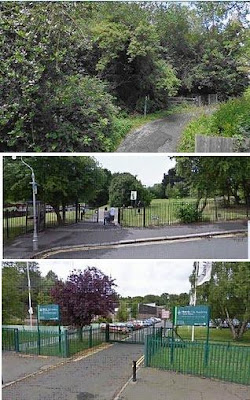
To incorporate a sense of verisimilitude we decided to film in and around school. This could be effective as it could show the character’s surroundings and it could also be quite easy for our actress to adapt to her surroundings. It is also a good location because school is like a second home for teenagers, and is a place where they learn values and learn what is right and wrong in society and they have the freedom to explore and challenge these ideas away from their parents.
To the left are some location shots.
Whilst creating the audience profile, I realised that I had my niche market and that the previous planning I had done would tie in with the demographic that I wanted to reach.
Callous - A Short Neo-Noir Film
















